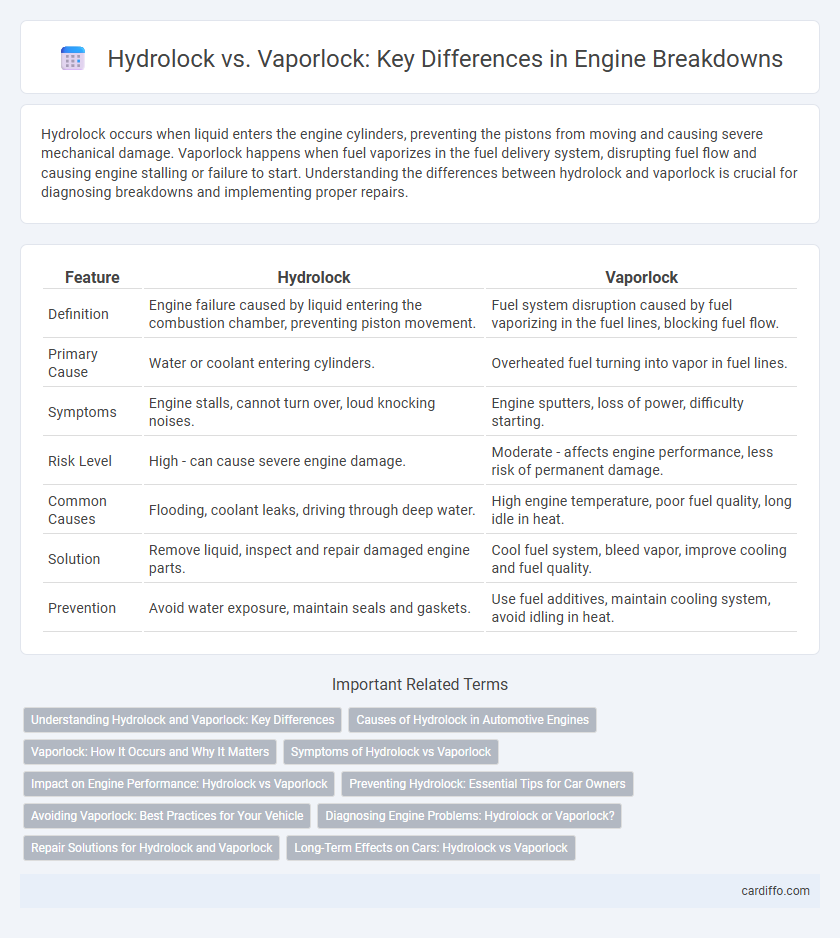Hydrolock occurs when liquid enters the engine cylinders, preventing the pistons from moving and causing severe mechanical damage. Vaporlock happens when fuel vaporizes in the fuel delivery system, disrupting fuel flow and causing engine stalling or failure to start. Understanding the differences between hydrolock and vaporlock is crucial for diagnosing breakdowns and implementing proper repairs.
Table of Comparison
| Feature | Hydrolock | Vaporlock |
|---|---|---|
| Definition | Engine failure caused by liquid entering the combustion chamber, preventing piston movement. | Fuel system disruption caused by fuel vaporizing in the fuel lines, blocking fuel flow. |
| Primary Cause | Water or coolant entering cylinders. | Overheated fuel turning into vapor in fuel lines. |
| Symptoms | Engine stalls, cannot turn over, loud knocking noises. | Engine sputters, loss of power, difficulty starting. |
| Risk Level | High - can cause severe engine damage. | Moderate - affects engine performance, less risk of permanent damage. |
| Common Causes | Flooding, coolant leaks, driving through deep water. | High engine temperature, poor fuel quality, long idle in heat. |
| Solution | Remove liquid, inspect and repair damaged engine parts. | Cool fuel system, bleed vapor, improve cooling and fuel quality. |
| Prevention | Avoid water exposure, maintain seals and gaskets. | Use fuel additives, maintain cooling system, avoid idling in heat. |
Understanding Hydrolock and Vaporlock: Key Differences
Hydrolock occurs when liquid enters the engine cylinders, preventing piston movement and causing severe mechanical damage, while vaporlock happens when fuel vaporizes in the fuel delivery system, leading to fuel flow interruption and engine stalling. Hydrolock typically results from water ingestion during heavy rain or flooding, whereas vaporlock is common in hot climates or high engine temperatures causing fuel overheating. Understanding these distinctions is crucial for diagnosing engine breakdowns and implementing appropriate repair strategies.
Causes of Hydrolock in Automotive Engines
Hydrolock occurs when a volume of liquid, typically water or coolant, enters the combustion chamber, preventing the piston from completing its travel due to the incompressibility of liquids. Common causes include driving through deep water, a blown head gasket allowing coolant to seep into cylinders, or a cracked engine block permitting coolant intrusion. This condition can cause severe mechanical damage such as bent connecting rods or cracked pistons, leading to costly engine repairs.
Vaporlock: How It Occurs and Why It Matters
Vaporlock occurs when fuel vaporizes in the fuel line or carburetor, causing a disruption in fuel flow to the engine and leading to stalling or failure to start. This phenomenon is common in high temperatures or engines with inadequate cooling systems, as excessive heat turns liquid fuel into vapor, blocking the fuel delivery system. Understanding vaporlock is crucial for preventing breakdowns and maintaining engine performance, especially in older vehicles or high-performance engines prone to overheating.
Symptoms of Hydrolock vs Vaporlock
Hydrolock symptoms include a sudden engine stall, inability to crank the engine, and bent or broken connecting rods due to water entering the combustion chamber. Vaporlock symptoms involve engine hesitation, stalling at high temperatures, and difficulty starting after the engine warms up because of fuel vaporization in the fuel lines. Recognizing these distinct symptoms helps differentiate hydrolock from vaporlock during engine breakdowns.
Impact on Engine Performance: Hydrolock vs Vaporlock
Hydrolock causes severe engine damage by forcing liquid into the combustion chamber, preventing piston movement and potentially bending rods or cracking the block. Vaporlock disrupts fuel delivery by vaporizing fuel in the lines, leading to engine stalling or hesitation without mechanical damage. Hydrolock results in catastrophic failure requiring extensive repairs, while vaporlock typically causes temporary performance loss and can be resolved by cooling the fuel system.
Preventing Hydrolock: Essential Tips for Car Owners
Preventing hydrolock involves avoiding driving through deep water, as water entering the engine cylinders can cause severe mechanical damage. Regularly inspecting and maintaining engine seals and intake systems reduces the risk of water intrusion that leads to hydrolock. Using waterproof engine covers and ensuring proper ventilation during heavy rain or flooding minimizes vaporlock, which disrupts fuel delivery and engine performance.
Avoiding Vaporlock: Best Practices for Your Vehicle
Prevent vaporlock by maintaining proper fuel system temperature and ensuring adequate ventilation to avoid fuel vapor buildup in your vehicle's lines. Use high-quality fuel with appropriate additives that increase vapor pressure resistance and store fuel in cool, shaded areas to reduce evaporation. Regularly inspect fuel lines and replace worn components to prevent leaks and heat exposure, ensuring optimal vehicle performance and reliability.
Diagnosing Engine Problems: Hydrolock or Vaporlock?
Diagnosing engine problems such as hydrolock or vaporlock involves identifying specific symptoms and causes related to each condition. Hydrolock occurs when liquid enters the combustion chamber, causing the engine to seize due to incompressible fluid, while vaporlock happens when fuel vaporizes in the fuel lines, leading to fuel delivery issues and engine stalling. Key diagnostic techniques include checking for engine turnover resistance in hydrolock and inspecting fuel lines and vapor barriers for vaporlock detection.
Repair Solutions for Hydrolock and Vaporlock
Repair solutions for hydrolock focus on removing water from the engine, replacing damaged components like pistons, rods, and gaskets, and thoroughly inspecting the crankshaft for warping. Vaporlock repair involves addressing fuel system issues by replacing or repairing faulty fuel pumps, cleaning clogged fuel lines, and ensuring proper vapor pressure regulation. Both issues require specialized mechanical expertise to prevent further damage and restore optimal engine performance.
Long-Term Effects on Cars: Hydrolock vs Vaporlock
Hydrolock causes severe engine damage by forcing liquid into the cylinders, potentially bending rods and cracking the engine block, resulting in costly repairs or engine replacement. Vaporlock leads to temporary engine stalling due to fuel vaporization in the fuel lines, which can reduce performance and fuel efficiency but rarely causes permanent damage. Understanding these long-term effects helps prioritize preventative maintenance to protect engine longevity and avoid expensive breakdowns.
Hydrolock vs vaporlock Infographic

 cardiffo.com
cardiffo.com